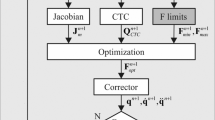Abstract
In this work, we implement a typical nonlinear Hill-type muscle model in a structure-preserving simulation framework and investigate the differences to standard simulations of muscle-actuated movements with MATLAB/Simulink. The latter is a common tool to solve dynamical problems, in particular, in biomechanic investigations. Despite the simplicity of the examples used for comparison, it becomes obvious that the MATLAB/Simulink integrators artificially loose or gain energy and angular momentum during dynamic simulations. The relative energy error of the MATLAB/Simulink integrators related to a very low actual muscle work can naturally reach large values, even higher than 100%. But also during periods with large muscle work, the relative energy error reaches up to 2%. Even in simulations with very small time steps, energy and angular momentum errors are still present using MATLAB/Simulink and can (at least partially) be responsible for phase errors in long-term simulations. This typical behaviour of commercial integrators is known to increase for more complex models or for computations with larger time steps, whose use is crucial for efficiency, especially in the context of optimal control simulations. In contrast to that, time-stepping schemes being derived from a discrete variational principle yield discrete analogues of the Euler–Lagrange equations and Noethers theorem. This ensures that the structure of the system is preserved, i.e. the simulation results are symplectic and momentum consistent and exhibit a good energy behaviour (no drift).
Similar content being viewed by others
References
Ackermann M, Schiehlen W (2006) Dynamic analysis of human gait disorder and metabolical cost estimation. Arch Appl Mech 75(10–12): 569–594
Betsch P, Leyendecker S (2006) The discrete null space method for the energy consistent integration of constrained mechanical systems. Part II: multibody dynamics. Int J Numer Meth Eng 67(4): 499–552
Brown IE, Scott S, Loeb GE (1996) Mechanics of feline soleus: II design and validation of a mathematical model. J Muscle Res Cell Motil 17: 221–233
Cheng EJ, Brown IE, Loeb GE (2000) Virtual muscle: a computational approach to understanding the effects of muscle properties on motor control. J Neurosci Methods 101: 117–130
Crowninshield RD, Brand RA (1981) A physiologically based criterion of muscle force prediction in locomotion. J Biomech 14(11): 793–801
Epstein M, Herzog W (1998) Theoretical models of skeletal muscle: biological and mathematical considerations. Wiley, New York
Friedman J, Flash T (2009) Trajectory of the index finger during grasping. Exp Brain Res 196(4): 497–509
Geyer H, Herr H (2010) A muscle-reflex model that encodes principles of legged mechanics produces human walking dynamics and muscle activities. IEEE Trans Neural Syst Rehabil Eng 18(3): 263–273
Geyer H, Seyfarth A, Blickhan R (2003) Positive force feedback in bouncing gaits. Proc Biol Sci 270: 2173–2183
Harding DC, Brandt KD, Hillberry BM (1993) Finger joint force minimization in pianists using optimization techniques. J Biomech 26(12): 1403–1412
Hill AV (1938) The heat of shortening and the dynamic constants of muscle. Proc R Soc B 126: 136–195
Leyendecker S, Marsden JE, Ortiz M (2008) Variational integrators for constrained dynamical systems. Z Angew Math Mech 88(9): 677–708
Leyendecker S, Ober-Blöbaum S, Marsden JE, Ortiz M (2010) Discrete mechanics and optimal control for constrained systems. Optim Contr Appl Meth. 31: 505–528
Lim CL, Jones NB, Spurgeon SK, Scott JJA (2003) Modelling of knee joint muscles during the swing phase of gait—a forward dynamics approach using MATLAB/Simulink. Simulat Model Pract Theor 11: 91–107
Maas R, Siebert T, Leyendecker S (2011) Structure preserving optimal control of finger movements. In: EUROMECH colloquium 511 biomechanics of human motion. Ponta Delgada, Azores
Marsden JE, Ratiu T (1999) Introduction to mechanics and symmetry: a basic exposition of classical mechanical systems (texts in applied mathematics), 2nd edn. Springer, New York
Marsden JE, West M (2001) Discrete mechanics and variational integrators. Acta Numer 10: 357–514
Neptune RR, Sasaki K, Kautz SA (2008) The effect of walking speed on muscle function and mechanical energetics. Gait Posture 28(1): 135–143
Santos VJ, Valero-Cuevas FJ (2006) Reported anatomical variability naturally leads to multimodal distributions of Denavit–Hartenberg parameters for the human thumb. IEEE T Bio-Med Eng 53(2): 155–163
Siebert T, Rode C, Herzog W, Till O, Blickhan R (2008) Nonlinearities make a difference: comparison of two common Hill-type models with real muscle. Biol Cybern 98(2): 133–143
The MathWorks Inc (2009) Matlab R2009b Documentation
Till O, Siebert T, Rode C, Blickhan R (2008) Characterization of isovelocity extension of activated muscle: a Hill-type model for eccentric contractions and a method for parameter determination. J Theor Biol 255: 176–187
Umberger BR, Gerritsen KGM, Martin PE (2003) A model of human muscle energy expenditure. Comput Meth Biomech Biomed Eng 6(2): 99–111
van den Bogert AJ, Gerritsen GK, Cole GK (1998) Human muscle modelling from a user’s perspective. J Electromyogr Kinesiol 8(2): 119–124
van Soest AJ, Bobbert MF (1993) The contribution of muscle properties in the control of explosive movements. Biol Cybern 69(3): 195–204
Winters JM, Woo SLY (1990) Multiple muscle systems: biomechanics and movement organization, 1st edn. Springer, New York
Zajac FE (1989) Muscle and tendon: properties, models, scaling, and application to biomechanics and motor control. Crit Rev Biomed Eng 17(4): 359–411
Author information
Authors and Affiliations
Corresponding author
Rights and permissions
About this article
Cite this article
Maas, R., Siebert, T. & Leyendecker, S. On the relevance of structure preservation to simulations of muscle actuated movements. Biomech Model Mechanobiol 11, 543–556 (2012). https://doi.org/10.1007/s10237-011-0332-0
Received:
Accepted:
Published:
Issue Date:
DOI: https://doi.org/10.1007/s10237-011-0332-0




